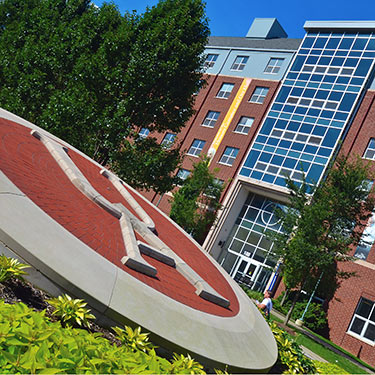Statistics, M.S.
Master of Science in Statistics
About the Degree
The master’s degree program in Statistics is designed to give students comprehensive training in the design, collection, and analysis of data. The program provides the student with a solid theoretical and applied statistical background in preparation for their chosen career. The program also prepares a student for continuing study at the Ph.D. level. The Master’s program in Statistics is directed toward students with a calculus-level background in mathematics.
The students in this program take core courses in the mathematical and probabilistic theory of statistics, applications of statistical methodology and statistical data management. Their depth and breadth of knowledge in these areas are reinforced and tested in a capstone course. Subsequently, they choose from a list of recommended elective courses intended to expose them to some advanced topics in statistics that supplement their knowledge in the core areas and prepare them for their future career path. They also get a taste of statistical consulting, gaining valuable experience in real-life problem solving and interaction with clients (from the industry or other fields of academia). To complete the degree program, the students must work on a thesis or a Master’s paper supervised by a faculty member and successfully defend it in a colloquium. Please see https://www.uakron.edu/statistics/academics/academics-Grad.dot for more details.
Salary and Career Outlook
The career outlook for statistics is excellent, to put it mildly. The employment prospect for people with Master’s (or higher) level expertise in most areas of statistics is now brighter than ever, and this trend is projected to continue in the foreseeable future. The demand for statisticians is currently increasing at the fastest rate ever and there is no end in sight. According to the Bureau of Labor Statistics, employment of statisticians with at least a Master’s degree is projected to grow 34% percent from 2016 to 2026, much faster than the average for all occupations. Growth is expected to result from increasingly widespread use of statistical analysis to make informed business, healthcare, and policy decisions. In particular, growth is expected to be strongly boosted by the ubiquity and inevitability of ‘big data’ in the immediate future, as statisticians are uniquely qualified to handle (i.e. clean, mine, model and infer from) such datasets.
The primary reason for this surge in demand is the remarkable flexibility that comes with a degree in statistics, enabling statisticians to ‘play in the backyard’ of every other quantitative field. Due the universal demand for their skills, statisticians hold a variety of job titles such as "quantitative analyst", "data analyst", "data mining analyst", "biostatistician", "biometrician", "statistical analyst", "analytics consultant", “data scientist,”etc. If somebody is interested in, for example, finance or actuary, then having a graduate background in statistics opens many avenues, so long as the graduate curriculum provides a solid programming experience in SAS or R (which our program does).
The salaries of statisticians with Master’s degrees working in the industry or various quantitative academic fields are outstanding, both at the entry level and at other levels of seniority. Based on the national salary data collected and compiled each year by the American Statistical Association, employees with a Master’s degree in statistics and working as entry-level:
- ‘statisticians’ have an average salary range of $50,884 – 98,400,
- ‘data analysts’ is $46,000 – 87,349,
- ‘statistical analysts’ is $44,163 – 108,614,
- ‘data scientists’ in the information technology sector is $54,117 – 107,659,
- ‘statistical programmers’ is $45,615 – 177,539,
- ‘senior data analysts’ is $65,000 – 88,615
- 'senior statisticians' is $76,282 – 106,932.
According to the Bureau of Labor Statistics, the median salary of statisticians with at least a Master’s degree was $75,560 in 2012 ($36.33 per hour) and has been in an upward trajectory since then.
Why Akron?
The Master’s degree in statistics offered here at the UA is the only one in northeast Ohio offered by a public university. Other public universities in this region house statisticians inside mathematics, applied mathematics or public health departments, but do not offer a graduate degree in this field. Case Western Reserve University offers a Master’s degree in biostatistics through their Dept. of Biostatistics, but not a program like ours.
Advantages of our program:
- Our program is a nice balance between the theoretical and methodological/applied aspects of statistics that prepares a student for a career in either the industry or the academia
- We have excellent placement record over many years
- Our students have the opportunity to learn from a faculty whose collective expertise covers a wide area within the field of statistics (e.g. biostatistics, bioinformatics, epidemiology, spatial statistics, Bayesian statistics, time series analysis, statistical computing and data management)
- Our students have the opportunity to choose career-enhancing electives such as actuarial science, time series, bioinformatics
- State-of-the-art computer labs and seminar series exposing students to a variety of topics presented by invited experts
- Exposure to, and first-hand experience in, statistical consulting and real-life interaction with clients
Recent graduates of this program can be found in jobs such as:
- Progressive Insurance Co. (Cleveland) as risk analyst
- J. P. Morgan Chase (Chicago) as data analyst and reporting analyst
- Alliance Data (Columbus) as consumer insights analyst and statistical consultant
Contact Information
Contact Information:
Dr. Tim O’Neil, Department Chair
(330) 972-6492
Dr. Mark Fridline, Associate Chair
(330) 972-8476
Dr. Sujay Datta, Graduate Adviser
(330) 972-6886

